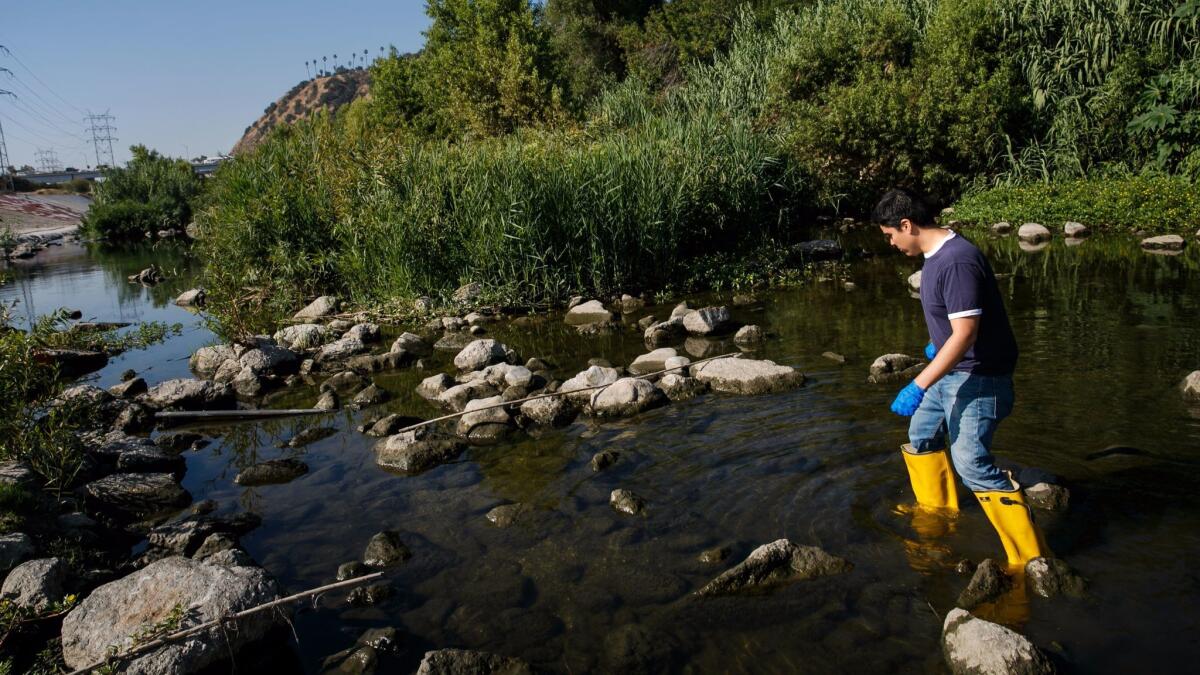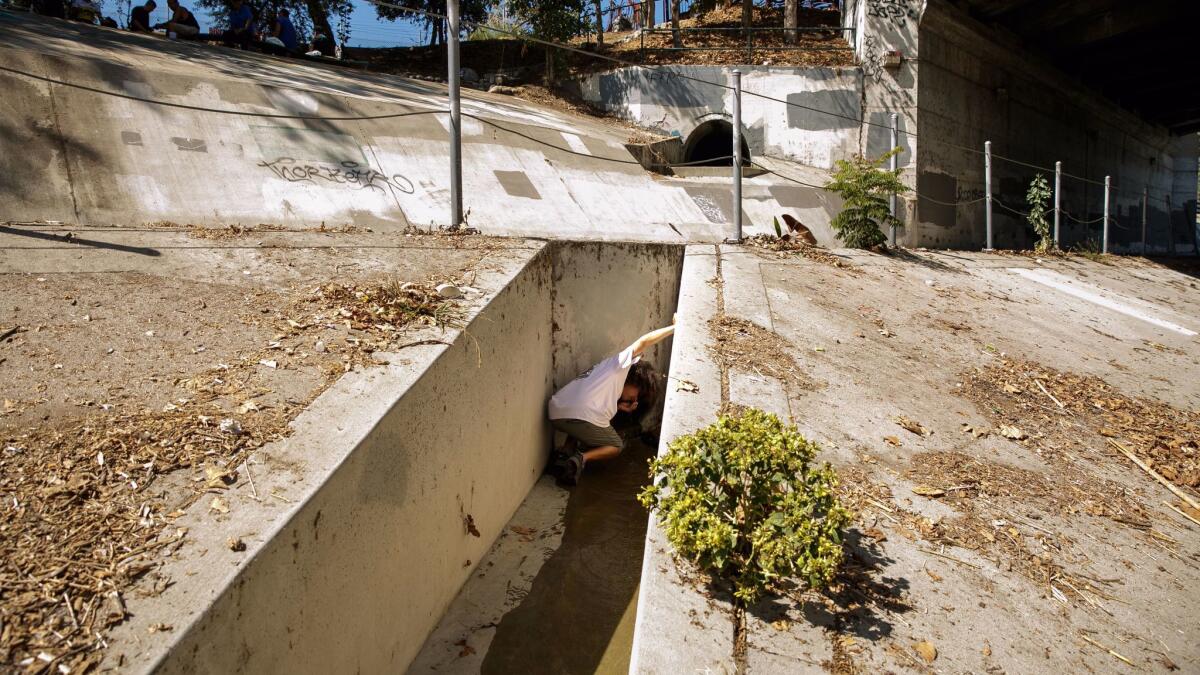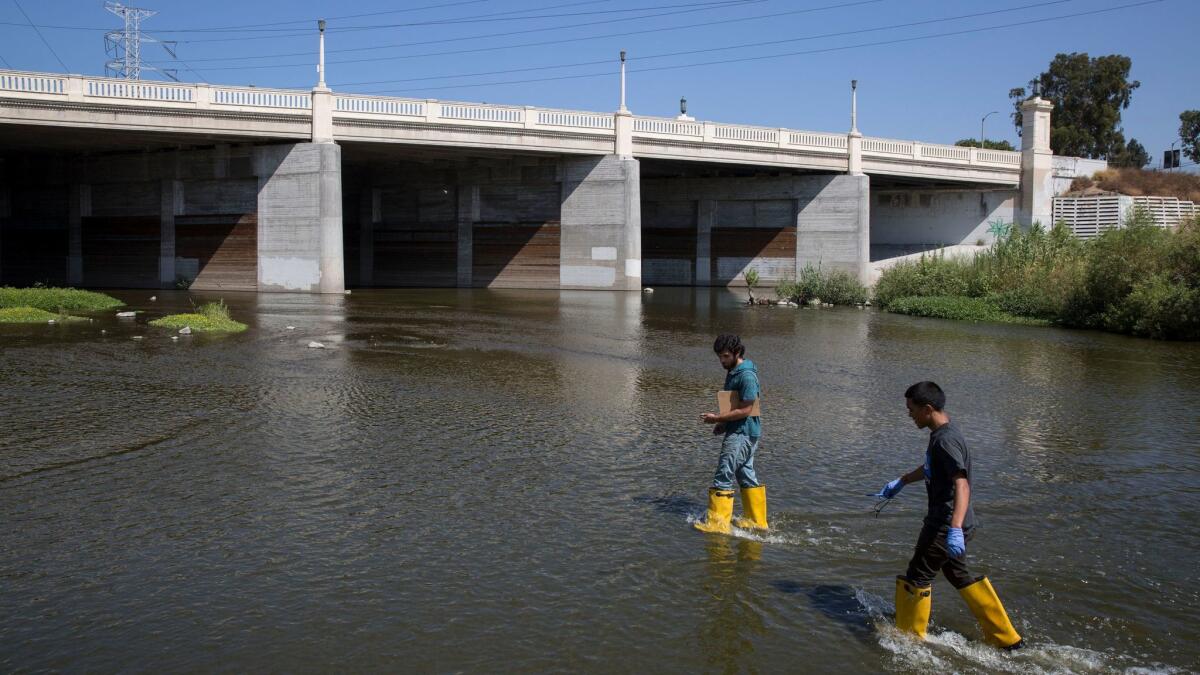Column: If we want a real river in L.A., we should start by cleaning up the water

- Share via
Nelson Chabarria says his love of chemistry began in a classroom at Los Angeles High, but he didn’t get to pursue a career right away. His Koreatown family needed help paying bills, so he went to work in the garment district and put the dream on hold for years.
But he never lost the bug, and at 34, he’s about to begin his second year of studying chemical technology at L.A. Trade Tech. And his summer job has made him all the more convinced about a career in environmental science.
One day last week, Chabarria stood in the middle of the Los Angeles River near Frogtown with water up to the tops of his boots. He wore rubber gloves, carried a small glass container, and stepped carefully over slippery rocks.
“Right here?” he called back to Katherine Pease, a watershed scientist with Heal the Bay.
Chabarria filled the bottle with river water, retreated back to shore and put the sample on ice to prepare it for testing back at the lab.
Big plans but big problems
Los Angeles has big, big plans for revitalizing an 11-mile stretch of the river over the next several years, at a price tag that began at $1 billion and soon bumped up to an estimated $1.6 billion.
But is the water clean enough for recreational use, or to be a draw for people to live or work along the banks of what amounts to a drainage ditch for urban storm runoff and treated sewage?
Heal the Bay is best known as one of the forces behind improving ocean water quality in Santa Monica Bay, issuing A-B-C-D-F grades for beaches. But for three years, the nonprofit has been grabbing samples from the Sepulveda Basin and three Elysian Valley river locations where there’s kayaking, fishing and even swimming. Using a green, yellow and red grading system, with red indicating the highest amounts of harmful bacteria, the results have varied from week to week.
Pease said water quality is somewhat better this year, but not everywhere, and not with any consistency. The Sepulveda Basin has had several reds this summer, and Elysian Valley readings at Frog Spot and Rattlesnake Park have had several yellows. Pease, in a report last year, said that high counts “indicate risk for ear infections, respiratory illnesses and gastrointestinal illnesses for people who come in contact with the water.”
That doesn’t mean you shouldn’t kayak the river — I did it last year, and highly recommend it. And it doesn’t mean you shouldn’t walk the banks of the river and take in the animal and plant life. But if you come into contact with the water, said Pease, you should wash your hands.
“I would definitely go kayaking,” said James Alamillo, who helps manage Heal the Bay’s river monitoring operation. “But I would not go swimming or wading in the water.”

Dangerous waters, not bath waters
And yet Alamillo and the rest of the monitoring team — which includes several L.A. Trade Tech students — regularly see homeless people and others swimming, bathing and fishing in the river.
A particularly good place not to do any of that is near the storm drains that dump contaminated runoff into the main channel. You might not expect torrents, or even trickles, from storm drains in the middle of another dry summer in Los Angeles, but the water flows day and night in some locations.
“The volume of water is crazy,” said Alamillo, who pointed out a gusher near the Fletcher Street Bridge.
It flowed with the force of about five garden hoses opened up full blast. The water has alternately been relatively clean, sudsy, and brown. Alamillo and others have checked surrounding streets in search of the origin, to no avail.
Pease said over-watering is a prime suspect, along with car washing. An estimated 100 million gallons or more of contaminated runoff shoots through L.A. County storm drains on a daily basis in summer, carrying with it animal feces, pesticides, chemicals, oils and trash. Alamillo picked up a plastic prescription marijuana container and said discards are as common along the L.A. River as plastic shopping bags were along Compton Creek when he and I trudged through the muck there several years ago.
On my second day with the monitoring team last week, the crew used bikes to travel the banks of the north side of the river. Samples were taken from three storm drains between Fletcher Drive and the Harbor Freeway. All three turned out to have high levels of both E. coli and enterococcus fecal indicator bacteria, and that came as no surprise.
Parked in the first drain was a shopping cart full of poop and toilet paper. A homeless man who lives in a tent city under Highway 2, and keeps four cats on leashes, said some of the people who live in the vicinity do their business in the storm drain.
Two nearby drains didn’t look much better, and one of them was a virtual waterfall, with sheets washing down the embankment and into the river. A young homeless guy named Abraham had just bathed in the river near there and was drying his clothes on the banks. With homeless people dying in the streets and bathing in the river, it’s obvious that efforts to do something about it are neither adequate nor urgent enough.
Los Angeles city and county officials have a lot to figure out in the coming months and years when it comes to what the L.A. River is, what it can and should be, how to clean it up and how to pay for its revitalization, even as estimates rise and support from Washington is expected to dry up. In fact, Heal the Bay’s monitoring program is covered by an EPA grant, and that federal agency is targeted for massive cuts.

The potential for an urban oasis
The river, historically, was dry nine or 10 months out of the year, and now flows year-round only because millions of gallons of treated sewage are released daily into the channel, all of it flowing out to sea.
Would we rather kayak 12 months out of the year on treated water and storm runoff, or invest in water reclamation projects to better handle droughts, or design a workable compromise?
The potential for an urban oasis through the heart of Los Angeles is huge, but will river-adjacent housing and commercial development — some of which is already underway — include or displace those now living in river neighborhoods?
I don’t have all the answers, but maybe the L.A. Trade Tech monitors I met will help us figure it out one day. Nelson Chabarria wants to be an environmental compliance inspector. Fellow students Vanessa Granados, Christopher Zamora and John Silva told me they want to go into environmental sciences, geo chemistry or related fields.
They know, better than most, the great potential and many challenges of a 51-mile river that precedes us all and travels along concrete channels for long, inglorious stretches, forever in search of an identity.
Get more of Steve Lopez’s work and follow him on Twitter @LATstevelopez
ALSO
After tons of drama with the California Coastal Commission, things are looking up
Jerry Brown talks a green game. So why isn’t California tougher on these polluters?
My close encounter with a shark got me out of the water — but not for long
More to Read
Sign up for Essential California
The most important California stories and recommendations in your inbox every morning.
You may occasionally receive promotional content from the Los Angeles Times.











